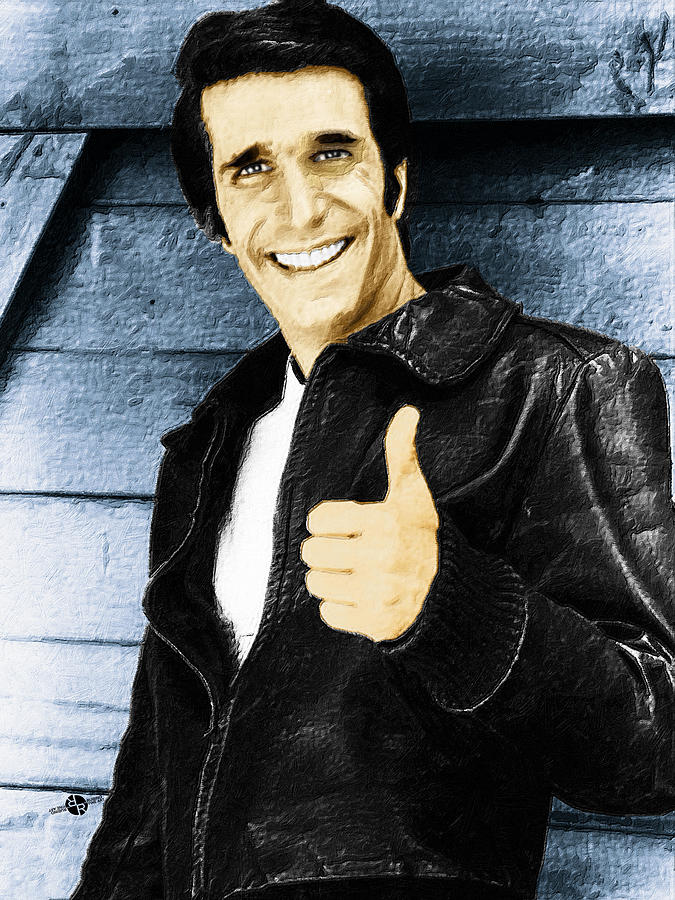WHY DOES TRAGIC TED PLAY THE SAME ELVIS RECORD FOR HOURS
EVERY DAY?
He might believe he’s Elvis.
The music might convince him
his one-bed flat is Graceland.
He might think he’s the Fonz.
He might be living out a fantasy
in which it’s still the Fifties
and he’s the tough young greaser
the girls all want to date.
The music might remind him of The One,
a love who died young,
caught forever in his memory
swinging tipsy round a lamppost
on the last night in his life
when he was ever truly happy.

Elvis Presley -- Glen Fortune Banse

Fonzie Happy Days -- Tony Rubin
Elvis presley (often referred to as just "Elvis") was known as the "King of Rock and Roll." He began his recording career in 1954. After a meteoric rise to superstardom, in 1956 he was hired to play a secondary role in the film "The Reno Brothers" about the 1st American train robbers, but the movie studio 20th Century Fox quickly expanded his part and give him 4 songs to perform. In the midst of filming Presley made his 1st appearance on "The Ed Sullivan Show" TV show (its 82.6% share of the television audience is still the largest in US history) and he debuted his version of the song "Love Me Tender," based on George R. Poulton's 1861 "Aura Lea" with new lyrics by Ken Darby. His recording of the song sold more than a million copies even before its release, the 1st single to sell a million; Fox quickly changed the movie's title to "Love Me Tender," though it did not give Presley top billing. Altogether, he starred in 32 other films. The following year he bought Graceland, a 13.8-acre (5.6 ha) estate in Memphis, Tennessee, and at 42 he died and was buried there in 1977. It is unclear how many master recordings he made (between 665 and 711); in the 1960s they were largely derived from his film work, and in the 1970s most of his work was recorded at his concerts; he is still the nest selling solo singer, with sales estimates ranging from 600 million to 1 billion. Composer and New York Philharmonic Orchestra conductor Leonard Bernstein called him "the greatest cultural force in the twentieth century. He introduced the beat to everything and he changed everything -— music, language, clothes."
ReplyDeleteIn 1972 Garry Marshall produced a pilot for a TV series which aired as a segment on the weekly "Love, American Style" anthology. Marshall was unable to sell the projected series, but the pilot inspired George Lucas to make the 1973 movie "American Graffiti" (he even used some of the show's cast members), and the American Broadcasting Company decided to air the series as a mid-season replacement, beginning 15 January 1974. For the 1st 2 seasons, when it focused on nostalgically depicting innocent adolescence in the 1950s, it was a modest success, but Marshall reinvigorated it in the 3rd season by spotlighting a previously minor biker character, Arthur "Fonzie"/"The Fonz" Fonzarelli, by moving him into the sitcom family's garage apartment making him more readily available as a character. He became the ultimate symbol of imperturbable "cool," and the series became the most-watched show on TV at the time. Actor Henry Winkler said of his role, "The Fonz was everybody I wasn't. He was everybody I wanted to be." Fonzie had the ability to make electrical equipment work simply by hitting it, and this "Fonzie touch" is still a term in common use, and a garage apartment is sometimes called a Fonzie flat. In 1999 "TV Guide" ranked him number 4 on its 50 Greatest TV Characters of All Time list. The shoe went off the air on 24 September 1984, after 255 episodes, and Fonzie was only one of 2 cast members who appeared on every episode. In 2008 Milwaukee, Wisconsin, where the series was set, unveiled Gerlad P. Sawyer's "Bronze Fonz" statue on its downtown Riverwalk.